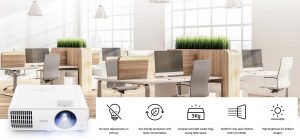BenQ Education Doubles Down on Sustainability With SmartEco 2.0 Projector Technology
 BenQ, an internationally renowned provider of visual display and collaboration solutions, is helping schools cut classroom projector energy costs with its new SmartEco 2.0 technology. BenQ’s new SmartEco projectors use laser and LED technology with special chips that evaluate the colors needed for each frame and adjust the power according to the content rather than only reducing the overall brightness like the traditional eco mode on a legacy LCD classroom projector. This means that without impacting the quality or the brightness of the picture, the projector can use up to one-third less power.
BenQ, an internationally renowned provider of visual display and collaboration solutions, is helping schools cut classroom projector energy costs with its new SmartEco 2.0 technology. BenQ’s new SmartEco projectors use laser and LED technology with special chips that evaluate the colors needed for each frame and adjust the power according to the content rather than only reducing the overall brightness like the traditional eco mode on a legacy LCD classroom projector. This means that without impacting the quality or the brightness of the picture, the projector can use up to one-third less power.
“For most school classrooms, projectors are one of the top consumers of electricity in the classroom. This is a key component in school district operating costs — which typically are the second largest expenditure for midsize and larger districts,” said Bob Wudeck, senior director of business development at BenQ Education. “BenQ SmartEco 2.0 was engineered to optimize brightness in response to the content for a drastic reduction in energy use without deteriorating the quality that can impact learning.”
The Power of LED and Laser Reducing Power Costs
BenQ SmartEco 2.0 technology brings together LED and laser chips to produce colored light that can be independently adjusted compared to a regular mercury lamp that only produces white light. In a BenQ SmartEco LED projector, there are individual red, blue, and green LEDs that the DLP chip mixes together to produce an image. By adjusting the amount of each color used for each frame, this solid-state lighting platform eliminates extra hardware costs and uses less power while ensuring a high-quality image. As an example, an all-white image on a BenQ SmartEco 2.0 projector will use full power while a forest scene with lots of green will use less power without changing the image on the screen. In comparison with other 4,000-lumen classroom projectors, the BenQ LH650 using SmartEco 2.0 technology can generate similar brightness and save a school up to 50% electricity compared to a legacy LCD projector using a mercury lamp.
Less Is More
In addition to less power consumption, the BenQ LH650 SmartEco projector features an eco-friendly design. It is made of 50% recycled plastic and it features a form factor that is half the size, resulting in less plastic, less fuel used in shipping, and less packaging and waste, including one-third less e-waste in comparison to a traditional lamp projector.
Additional Costs Savings
The cost savings for BenQ’s SmartEco 2.0 projectors stack on top of the additional cost savings built into its family of projectors. First, there is no monthly or annual filter cleaning. Every BenQ SmartEco projector is designed with an advanced sealed engine that eliminates the need for cleaning or changing messy filters that are required to avoid projector overheating. The sealed image keeps out dust that can cause a shortened life span. Second, they prevent yellowing and don’t require convergence adjustments. Every BenQ SmartEco projector uses the same technology used in commercial cinema projectors and is warranted against yellowing. In addition, the single chip design eliminates the need to adjust the three different panels when they get misaligned. Finally, there are no expensive replacement lamps. By eliminating mercury lamps, a BenQ SmartEco projector can last as long as 30,000 hours — 24,000 hours longer than an LCD lamp projector that must be completely replaced at 6,000 hours use.
More information on BenQ’s latest SmartEco 2.0 projectors and energy savings is available at www.benq.com/en-us/education/edtech-blog/how-new-smarteco-projector-technology-can-lower-electricity-cost.html.




